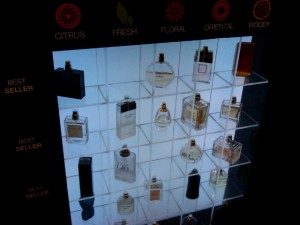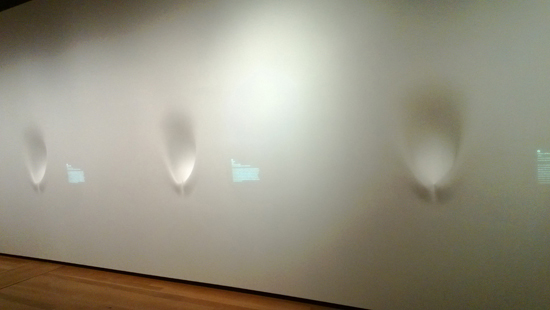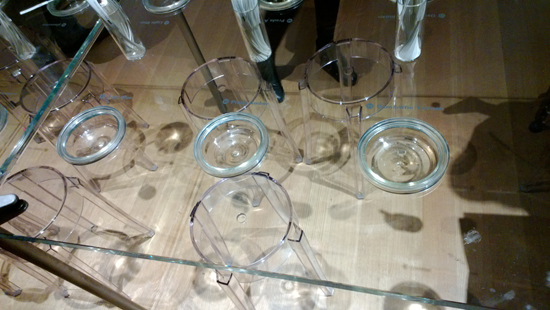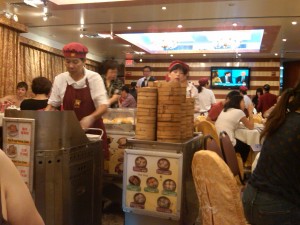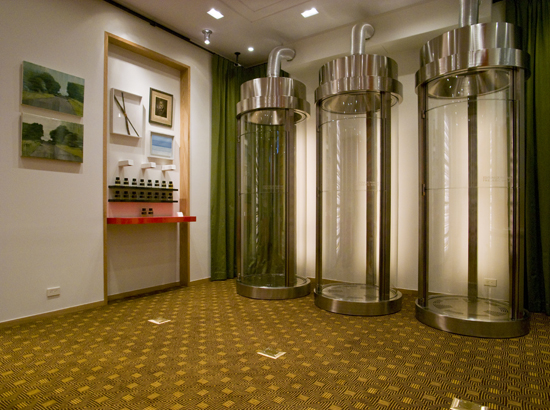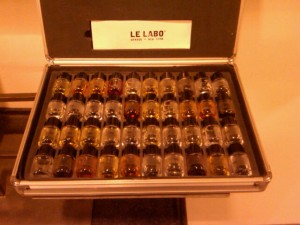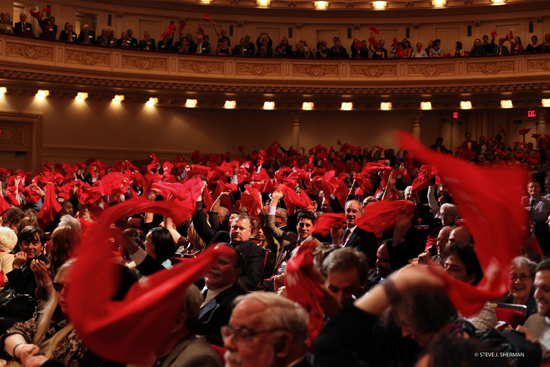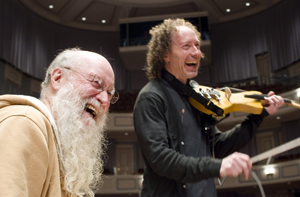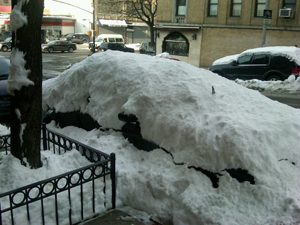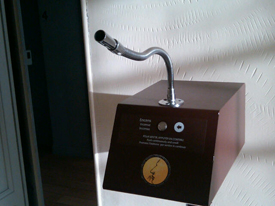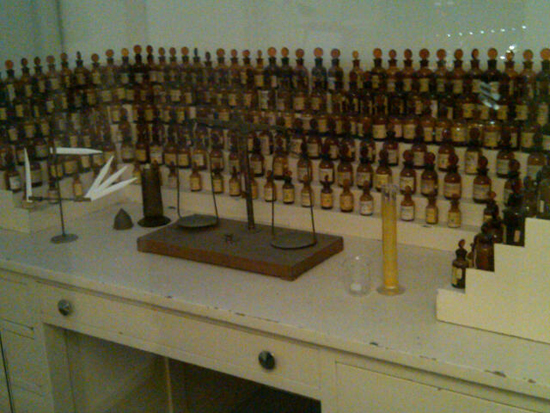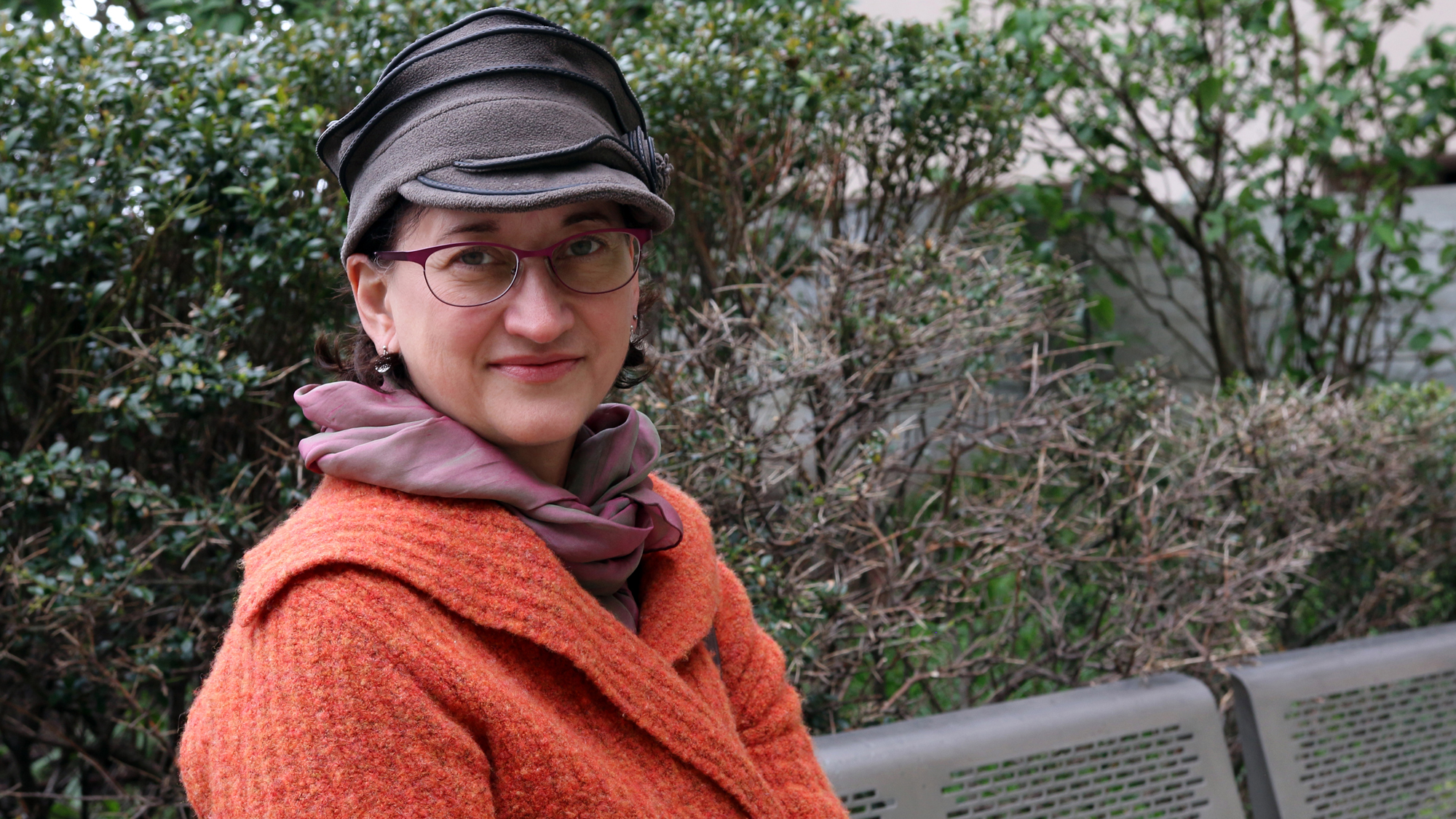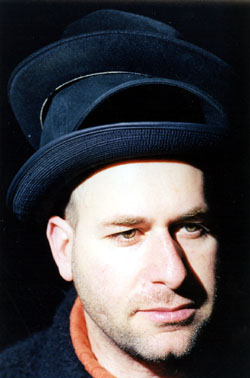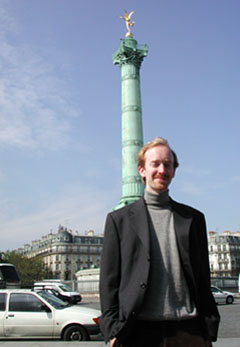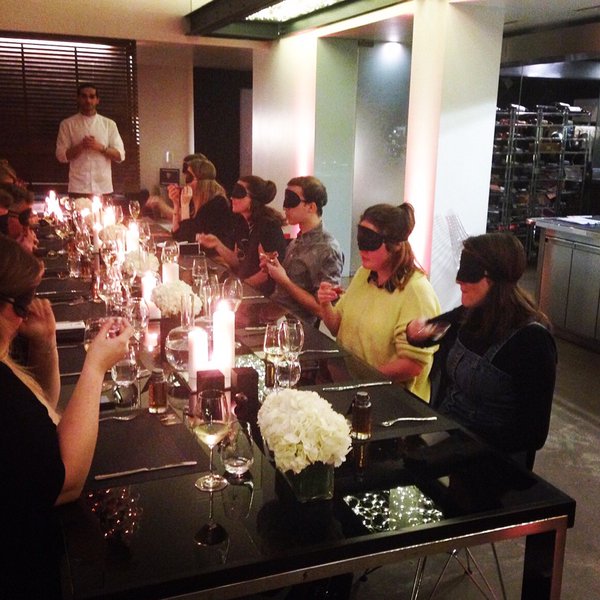

Jozef Youssef presents a multisensory meal for the launch of a new Hugo Boss fragrance. (Photo courtesy Kitchen Theory)
I spent the weekend composing two new pieces of music for another collaboration with chef Jozef Youssef of Kitchen Theory. This time around I was tasked with bringing out the sweet and sour elements of a lavender and pomegranate-based tapioca dessert, part of a multisensory meal that Youssef was organizing for the launch of a new Hugo Boss fragrance. (Previously, I composed music to bring out the sweet and bitter notes in Chivas Regal 18 Ultimate Cask Collection blended Scotch whisky for a similar event.)
My sweet texture is pretty similar to the sweet texture I wrote for the whisky pairing: consonant intervals and mellow timbres in a relatively high register, organized in short, ascending phrases, with a sprinkling of wind chimes.
The sour texture, while similarly drawing on the psychological literature of Charles Spence’s Crossmodal Research Lab at Oxford University, is a bit looser in its interpretation of the research. I used bright, buzzy timbres and descending phrases for contrast, and I picked up on an idea from the music I wrote for a 2012 Azul y Garanza Garciano to depict tartness with dissonance, not only in the musical intervals, but also in the slight detuning of my subtly shifting delay effect. To give me a wider continuum of intervals from which to choose, I composed my music in Harry Partch’s 43-note per octave scale, which allowed me to incorporate his notions of comparative consonance (the simpler the ratio, the more consonant the interval, which is the best explanation of consonance vs. dissonance I’ve encountered and serves as a finely graduated yardstick for crossmodal inquiry). I interpreted the faster tempi that have been linked to sourness in psychological studies more generally as high rhythmic density, reflected in my texture’s pulsating elements. Sourness feels higher than sweetness to me, so this piece is in a slightly higher register as well.
While I wasn’t specifically composing music to accompany a scent, scent plays a vital role in dining, and I think the challenges to accompanying scent with music are similar to taste.
Taste and smell are our chemical senses. They are what allow us to interrogate the makeup of our environment, providing information that perhaps might lead us in the direction of dinner or cause us to spit out something poisonous. The visual arts and the sonic arts arrive to us from a distance, via electromagnetic radiation or fluctuations in air pressure, but taste and smell require direct contact.
Philosophers have long debated whether the fundamentally different nature of these chemical senses precludes the elaboration of an art of ideas based on them, something that goes beyond the ancient and sophisticated traditions of perfumery or cuisine. Taste, which requires a visible delivery mechanism, perhaps has a leg up on smell, which is invisible (like music).
A few years ago, Chandler Burr lobbied New York’s Museum of Arts and Design to establish a new Department of Olfactory Art and was subsequently brought on as its head. His brief tenure culminated in the 2012 exhibition The Art of Scent 1889-2012. A man of passionate pronouncements, he comes right out and says of perfume, “It’s art.”
I’m happy to accept, along with Marcel Duchamp, that if someone proclaims his or her work as art, it’s art. However I’m not sure whether, during the long history of perfume-making, most perfumers have actually been making that claim. We’re not talking about the gradual acceptance of a new technology; unlike photography or video games (my primary arena of activity for the past twenty years, which only recently emerged from its own “is it art?” debate), perfume has been around for a very long time. It might take a little more work than the wholesale rebranding of an existing discipline to bring perfume and art into the same conversation. Perhaps we can repurpose Wittgenstein’s dictum that not every building is architecture to suggest that not every perfume is a work of olfactory art.
(Incidentally, while I’ve seen a couple of announcements in recent years about companies bringing the sense of smell into gaming, my very first game, the maybe not so great Leisure Suit Larry 7: Love for Sail!, may well be the first, way back in 1996. The game shipped with a scratch and sniff card, and at key junctures in the game, the “Cybersniff 2000” logo would flash and a sound would play (my processed voice), informing the player which of the nine squares to scratch, neatly addressing the question of synchronization. The soundtrack also featured a 12-tone faux-jazz composition, the sure mark of a young composer fresh out of music school.)
One of the considerations is practicality. In an interview with The New York Times, Holly Hotchner, the former director of the Museum of Art and Design in New York City who brought Chandler Burr on board, conceded that “perfume by its nature has to be wearable, which is not true of other art forms.” Paul A. Young, a London-based chocolatier who devised a charcoal-flavored chocolate to accompany a Francis Bacon painting at the Tate Sensorium exhibition acknowledges the assumption that food should be pleasurable when he says, “Some people will find it repulsive and not want to eat it, some will find it engaging and some people will love it.”
Music has always been considered an art form, but in the last few decades, sound art has emerged and evolved as a parallel practice distinct from music (although I think sound artists ignore the history of music at their peril). There’s no quantifiable difference between sound art and music. The materials are exactly the same; it’s a question of focus. With all of the current interest surrounding food and multisensory perception, I’ve been thinking for a while that taste and smell may be next in line to be appropriated by the art world. But this question of focus highlights the challenges that can arise when people from different creative disciplines come together (as I described in an earlier essay).
As an example, when I attended “The Architecture of Taste,” Pierre Hermé’s presentation at the Harvard Graduate School of Design a few years ago, it was fascinating to get a glimpse into a great chef’s creative process, and the pastry samples were amazing, but it was clear, especially during the Q&A afterwards, that he was thinking of his work in very different terms from the concerns of art and design grad students. Another leading pastry chef, Jordi Roca of El Celler de Can Roca, discussed his relationship to art in the film that documents the multimedia meal El Somni, devised alongside the other two Roca brothers, concluding simply, “I’m just a pastry chef.”
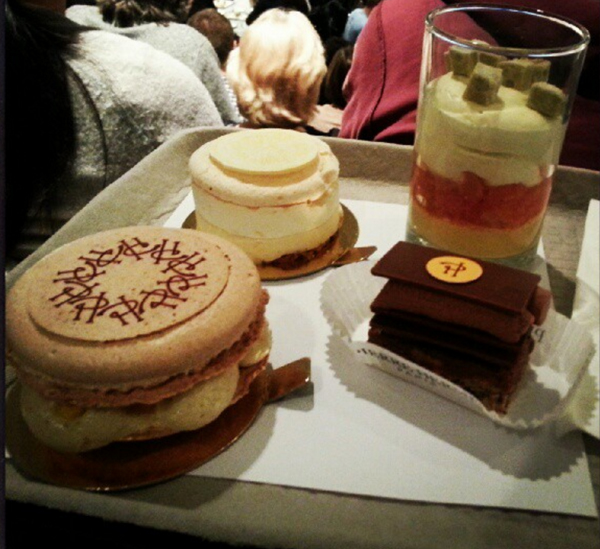
Desserts served at Pierre Hermé’s Harvard lecture included an “infringement citron” and other desserts made from unconventional ingredients such as wasabi. (Photo by Ben Houge.)
Dean Dutton provides a good overview of the issues surrounding the notion of olfactory art in his book The Art Instinct, and as I’ve been doing projects that combine food and music, it’s been useful for me to consider these arguments from a musical perspective.
One issue that he dismisses a bit too quickly, I think, is the idea of “internal relations.” He borrows this term from philosopher Monroe Beardsley, pointing out that, while we may recognize corresponding proportional relationships in the spatial layouts of a painting or the intervals of a musical chord, chemical compounds don’t lend themselves to this kind of perceptual organization that can serve as the basis for large, sophisticated structures. There’s no equivalent to an octave or a major 7 sharp 11 chord or a retrograde inversion that would allow a composer like Bach to spin out a ten-minute fugue from a subject of just a few notes. The wine aroma wheel is nowhere near as precise as a color wheel (can you rotate a raspberry note 180 degrees to obtain its opposite?) or the circle of fifths (what’s the secondary dominant of leather?).
A second obstacle is a question of the delivery mechanism, and here I’m thinking about a time-based sequencing or counterpoint of multiple scents that goes beyond the natural diffusion of a scent in the air once it is sprayed or applied. (This is more of an issue for scent than taste.) To think of scent in musical, time-based terms, it’s a challenge to consistently deliver a scent and take it away, allowing for temporal contrast. This issue thwarted some of the historical efforts to bring scent into cinema, such as Smell-O-Vision from 1959.
Many approaches to scent diffusion have been developed with varying levels of technological overhead. The Museum of Art and Design’s Art of Scent exhibition took place in a spare, white room, designed by Diller Scofidio + Renfro, laudably devoid of packaging and other marketing detritus. As visitors inclined their heads over small indentations in the wall, a puff of scent emerged from a sophisticated mechanism designed by Scent Communication in Germany. At Green Aria: A Scentopera, a collaboration between entrepreneur/writer/director Stewart Matthew, perfumer Christophe Laudamiel, and composers Nico Muhly and Valgeir Sigurdsson which premiered at the Guggenheim in New York City in 2009 (about which NewMusicBox’s Frank J. Oteri has written extensively), scent was delivered to each spectator via a “scent microphone” (functionally more like a “scent speaker”) at each seat, which could be positioned as close to the nose as desired. The inaugural installation of the recently opened Museum of Food and Drink in Brooklyn, masterminded by cocktail impresario Dave Arnold, features a “Smell Synth” that allows visitors to experiment with different odor compound combinations at the push of a button. This echoes the “Olfactiano,” a “scent piano” developed by Peter De Cupere, which he has used for time-based scent-oriented performances such as his Scentsonata for Brussels presented at the Cordoba festival in 2004. At the Crossmodalist rehearsal I attended in London last April, the technique was low-tech but effective; I was blindfolded, and different perfumes (designed by Nadjib Achaibou to evoke concepts such as “lust” and “sorrow”) were manually wafted in my direction, sometimes simultaneously, by unseen hands at different moments of Chris Lloyd’s live performance of Liszt’s piano transcription of Wagner’s “Liebestod.”
A third consideration is representation. I’ve written in the past about what I called the “abstract” quality that food and sound share. By this I meant that, while music can be linked to an external narrative via text or theatrical context, coherence is essentially the result of internal relations, to return to Monroe Beardsley’s term, i.e., a note has meaning in the context of a chord or scale or harmonic structure and how these structures evolve in time. Even without recourse to the same kinds of internal relations as music, tastes and scents are constructed and developed by combining chemical compounds. This is in contrast to the visual and literary arts like painting, sculpture, choreography, cinema, literature, poetry, and video games, in which meaning-making via external representation is the norm. I think it’s important to consider that an extracted chemical essence of an object is still a form or an attribute of the object; the scent of a rose derived from a rose cannot be said to represent a rose in the way that a painting represents a rose, because in a real sense that essence actually is the rose. Representation is the use of one thing to depict another thing; as Magritte put it, “Ceci n’est pas une pipe,” and no pipe extracts are required to produce a painting of a pipe.
My usage is different from the way the term is used, for example, in Annick Le Guérer’s article “Olfaction and Cognition: a Philosophical and Psychoanalytic View” in the weighty 2002 compendium Olfaction, Taste, and Cognition. Here, the historical assertion (shared by numerous philosophers) is that scent is not “capable of abstraction,” by which she means that a common attribute cannot be extracted from multiple scents in the way that we might refer to an abstract color. This is reflected in the lack of vocabulary for describing scents (at least in English); we generally simply describe scents according to their sources or, in the case of synthetic compounds, by analogy.
So perhaps my earlier usage of the term is nonstandard, but I think the ideas are related: just as mimetic music was by far the exception prior to the advent of recording technology (with timpani evoking thunder in Berlioz’s Symphonie Fantastique serving as an example of a rare exception), it’s difficult for a taste or a smell to be “about” anything other than itself.
I’ve heard people assert that what music represents is emotion, and I could imagine this argument being applied to smell or taste, but evoking and representing are not the same thing. As Frank J. Oteri pointed out in our recent correspondence on the subject, “Associations (e.g. major = happy, minor = sad) are the result of acculturation and not universal. The same, though, could be said for scent.” He notes the curious coincidence that, as I mentioned above, music and scent are completely invisible.
I’ve also heard some people conflate tonality with representation, and there certainly are clear parallels between figurative painting in the visual arts and tonal structures in music, but tonality strictly speaking still does not represent anything outside of music’s “internal relations,” and in fact it is these relations that give tonality meaning. Nonetheless it is certainly worth observing that abstraction in painting and tonality in music experienced parallel ruptures in the tumultuous early 20th century, and it is surely a result of the same cultural forces that Chanel No. 5 was introduced in 1921, unprecedented in its lack of reference to natural scents, “a perfume like nothing else,” in the words of Coco Chanel.
At a certain point, while pondering these questions, I realized that music has been here before. Like many undergraduate music students, I read about the absolute vs. program music debate in my music history classes, and (like a lot of students, I suspect) I was left wondering what the big deal was. On one side of this virulent debate you had Richard Wagner espousing opera as a total art form driven by narrative and deriving power from the coupling of art forms, while on the other side Eduard Hanslick argued for purely instrumental music as the art form’s pinnacle of expression. I recently picked up Mark Evan Bonds’s excellent new book on the subject and realized just how far back this question goes. He organizes his argument around the ideas of essence (what music is) and effect (what it does). This historical perspective has the potential to serve as a useful framing device for discussions of an art based on the chemical senses.
There is a category of “olfactory artists” that has emerged as a distinct practice from that of perfumers, and it seems to be expanding rapidly. Many of the artists working with scent are not working only with scent, and often they’re not working alone. Some of these artists are crafting the scents themselves, but oftentimes the chemical component is outsourced. Pamela Rosenkranz worked with perfumers Dominique Ropion and Frédéric Malle and sound designer Emar Vegt on Our Product, an installation at this year’s Venice Biennale that presented a huge pool of liquid the color of an averaged European.skin tone. Belgian artist Peter De Cupere, perhaps the best known artist in this arena, has been working with scent since the 90s, often incorporating smells into large-scale mixed media sculptures, as in The Smell of a Stranger, presented at the Havana Biennial, which engineers indigenous Cuban plants to give off scents redolent of Western culture. Brian Goeltzenleuchter has been working on a project to capture the smell of each neighborhood in Los Angeles.
Arnica Yi’s 6,070,430k of Digital Spit, presented last summer at MIT’s List Visual Arts Center, bridged the worlds of scent and taste by building an immersive installation inspired by the “Mint Pond” dish at Ferran Adrià’s elBulli restaurant. She notes, “I think the most radical artistic statements are being made in the world of cuisine. That interest translates and seeps into my approach to smell. Even though I don’t work with food, I feel the sensibilities are shared.”
Soundscape for Pamela Rosenkranz – Our Product. Swiss Pavilion at Biennale Venice 2015 from Emar Vegt on Vimeo.The high degree of collaboration that many artists are already exploring points one way forward for an art of the chemical senses. Maybe the lack of “internal relations” and problems of diffusion preclude certain types of standalone olfactory expressions, but by linking art forms, sophisticated new kinds of experiences are possible. Let music aid with the time-based elements. It’s not unlike setting a text or scoring a film; another art form defines the structure. Ramón Perisé of Mugaritz writes that, “how cooking can participate in a multisensory spectacle is something that, in my opinion, is in the first phases of exploration.” The idea of putting different art forms together into a multimedia event is the reason I chose the term “food opera” for my project in the first place.
Listening to music is something we do together. So is dining. As I’ve been working on my food opera project, I’ve spent a lot of time thinking about the overlap between these two spaces: the restaurant and the concert hall. Food represents community, maybe literally, in the same sense of the word I used when writing about “representation” earlier. When we think of fellowship, we often speak of breaking bread together. Dining is one mode of being in the world together.
To orchestrate a communal dining experience as an artwork is the kind of tactic associated with the relational aesthetics movement of the 90’s. Rirkrit Tiravanija’s 1992 piece Untitled (Free), now in the collection of New York’s Museum of Modern Art, involved distributing free curry and rice to visitors in a gallery space, and since then, Tiravanija has presented a number of other pieces that involve people coming together to eat. Together with his longtime gallerist, Gavin Brown (a collaborator on the original exhibition of Untitled [Free]), he has been developing a commercial kitchen in Hancock, NY, called Unclebrother. In a recent interview, he highlighted some of the same community-oriented values I emphasize in my work, “It’s about eating from your surroundings.”
This is a big part of what my food opera project is about. I have observed that these events promote community in a unique way. Because each seat in a restaurant has its own speaker and functions as a source of music, diners become more aware of the people around them and in fact depend on the presence of other diners to complete their experience. The music foregrounded at each diner’s table becomes the accompaniment for the person at the adjacent table, such that everyone in the restaurant is involved, through their choice of dish and the rhythms of their meal, in facilitating the overall musical experience. There’s a lateral exchange of information that is unlike a typical concert; sound passes not just from performer to audience, but from diner to diner. This strikes me as a rich yet underexplored model for musical communication (something I’ve also explored in my piece The Tomb of the Grammarian Lysias, a setting of a Greek poem by Constantine P. Cavafy for unamplified voice and audience mobile devices).
At several events, we’ve gone so far as to incorporate field recordings from the farms that provide the ingredients and interviews with farmers into the soundscape, since Jason Bond, the chef with whom I’ve collaborated on these projects, is a passionate supporter of local, sustainable agriculture. We used sound to literally bring farm to table. My hope is that diners leave the restaurant with an increased sense of their interdependent roles in a larger ecosystem, which may encourage more responsible food consumption choices.
When I was attempting, in my poor Spanish, to describe this aspect of my work to chef Dani Lasa at Mugaritz, he understood immediately and responded with the perfect word: “complicidad.” Complicity. I asked if Mugaritz had ever done a dish involving sound, not in their various multimedia collaborations, but actually in the dining room. Dani told me about a dish called Mortar Soup with Spices, Seeds, Fish Broth, and Fresh Herbs. No matter at what stage people were in their meals, the entire restaurant was served the dish at the same time, and as each diner applied the pestle to the mortar, the whole room rang with a sound like Tibetan singing bowls. This experience was enabled by the restaurant, but enacted by each individual diner; everyone was complicit in the resulting sound.
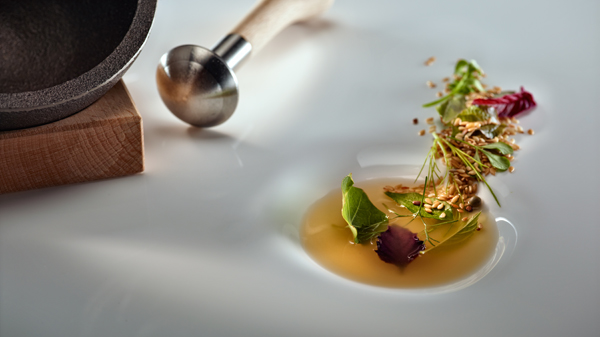
Sopa de mortero con especias, semillas, caldo de pescados y hierbas frescas. (Photo courtesy Mugaritz.)
I hesitate to add this coda, but I feel this is an important point. I’ve been writing this essay in the wake of the terrorist attacks in Paris, and in Beirut before that, and of course you can keep going as far back as you like. In these factious times, more than ever we need to find ways to understand those whom we perceive as being different from ourselves as part of the same ecosystem, complicit in the well being of the world. As someone who’s lived a third of his life outside of his home country, I believe that cultivating empathy for others via direct interaction is the best hope for peace. One of the best ways to do this is to come together over a meal. Just as our chemical senses—Le Guérer uses the term “proximity senses”—require contact to perceive our surroundings, we need situations that allow us to come together and better understand our neighbors on this planet. When we break bread together, a meal can do that.


